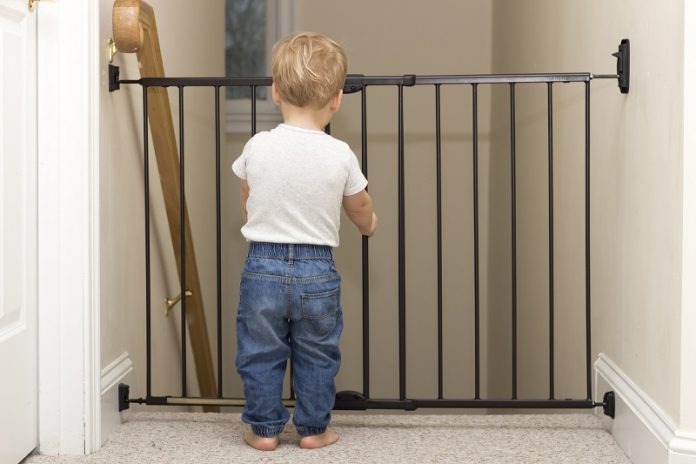If you’re anxious about bringing new life into the world, you’re not alone. With so many hazards around the home, all first-time parents bring their newborn home with a sense of fear, as well as tremendous joy, of course.
If you have one important job as a parent it’s to protect your child, so babyproofing your home before they enter the world is the best place to start before your parenting journey really kicks off.
Learn how to prepare for a baby and keep them as safe as can be with these top safety tips.
Table of Contents
Common Home Hazards to Be Aware Of
As a new parent, you tend to view the world with a fresh set of eyes when you are 100% responsible for the life and safety of a child. Everything might start to look like a threat, but here are some of the most common hazards around the home you should really be aware of:
- Falling and tripping hazards: furniture, the changing table, the bathtub, loose rugs, wires, and extension cords all pose a fall or trip hazard for babies and toddlers
- Burns: children from the age of two years old are commonly burned by hot liquids in the kitchen as they tend to grab and pull at things out of curiosity
- Poisoning: harmful cleaning products and medications that are left in open cabinets, at ground level, pose a real threat to children and babies, try cabinet locks to keep these products safe
- Choking: babies and toddlers put things in their mouths whenever they can, small items such as fridge magnets, coins, buttons, etc., all pose a choking risk
- Electrocution: exposed electrical outlets are often poked and prodded by curious babies and toddlers
- Sleep suffocation: this is caused by excessive sleep paraphernalia in children’s beds or cots, such as pillows, blankets, stuffed toys, etc.
- Serious injury: all-too-often, babies and toddlers are severely injured by unanchored items of furniture that topple over as children climb or mount them
Finally, drowning is a very common home accident that happens across the U.S. Babies are at risk of drowning in even the smallest amount of water in the bathtub. It’s important to watch your child like a hawk around any form of water while they are very young.
10 Baby-Proofing Tips on How to Prepare For a Baby
One of the best ways to get a good perspective as an infant or toddler is to think like a baby. Do a thorough overview of each room in your home, get down to their level, and take note of all the potential hazards that could catch their attention.
1. Keep Cabinets Closed With Latches and Locks
It’s always a good idea to baby-proof low or ground-level cabinets with locks and latches. This is especially important for cabinets with cleaning products, medication, pots and pans, machinery, and electronics.
2. Keep Your Baby Out of the Kitchen
The kitchen is a hazard hot zone in any home. So it’s best to keep babies and toddlers out of this area altogether when cooking or cleaning. Set up a contained play area or swing that you can keep an eye on, while they keep themselves entertained.
3. Change Up Your Cleaning Supplies
With a little one in the home who is exceptionally vulnerable to chemicals, you may want to re-think the types of cleaning products you use. It’s safer to rid your home of toxic cleaning chemicals to reduce the risk of poisoning.
There is a myriad of baby-friendly cleaning products on the market today that are healthier for your home and family.
4. Use a Medications Lock Box
Even if you use a cabinet lock for your medication cupboard, it’s wise to lock your medications away inside a lockbox on the off chance your child finds their way into this cabinet. Also, make sure your child does not see where you stash your medication lockbox, they have amazing memories and will seek it out!
5. Secure All Loose, Dangling Cords
Loose cords and wires are like magnets to small children. Out of sheer curiosity, they will pull, grab, and tug on any cords or wires that they can reach. This can lead to severe injury as heavy appliances can topple over before you have a chance to intervene. So make sure they are tucked away and secured out-of-reach.
6. Consider Carpeting For Your Home
We get it, carpeting and children are not the best combination. But while your child is still young and learning to sit, crawl, and walk, carpeting is one of the best ways to cushion their falls as they find their balance. If you don’t want to completely install carpeting, consider purchasing a thick rug or two for key rooms in your home, like the living room.
7. Reduce All Climbing Temptations
Small children have a habit of climbing and mounting pieces of furniture in order to explore and reach objects that may have caught their eye. They are persistent and will take on almost any piece of furniture. This is why it’s so important to remove all climbing temptations and safely anchor items of furniture so they don’t topple over. Anchor tall chests of drawers, cabinets, and TVs to the wall for extra safety.
8. Always Use a Baby Monitor
As a new parent, the first place you should install a baby monitor or camera is in the nursery. This is so that you can keep an eye on their sleeping position, whether they’re awake or not, or their behavior when left unattended.
However, make sure the baby monitor is secured out of their reach and does not have any exposed or loose wiring which may pose a risk to your child.
9. Keep Sleeping Paraphernalia to a Minimum
Reduce the risk of sleep suffocation by removing all pillows, extra blankets, fluffy, stuffed toys from your baby’s crib. The reality is that your baby doesn’t need a pillow or extra blankets — it’s all unnecessary and poses too much risk.
10. Always Use a Baby Gate
If your home has stairs, a balcony, or even an area with a small ledge, a baby gate is imperative. Baby gates are easy to install as they’re non-permanent and can be removed at any time. Use a baby gate at the top and foot of a stairway, or to block off any other dangerous areas as your child begins to crawl and walk.
Learn More About Becoming a New Parent Here
Now that you know a little more about how to prepare for a baby and create a home safe haven, we hope you feel excited and ready for the arrival of your little one.
If you’re looking to learn more about parenting, children, good nutrition, and education, check out the lifestyle section of this blog and brush up on all the parenting advice you need.
















